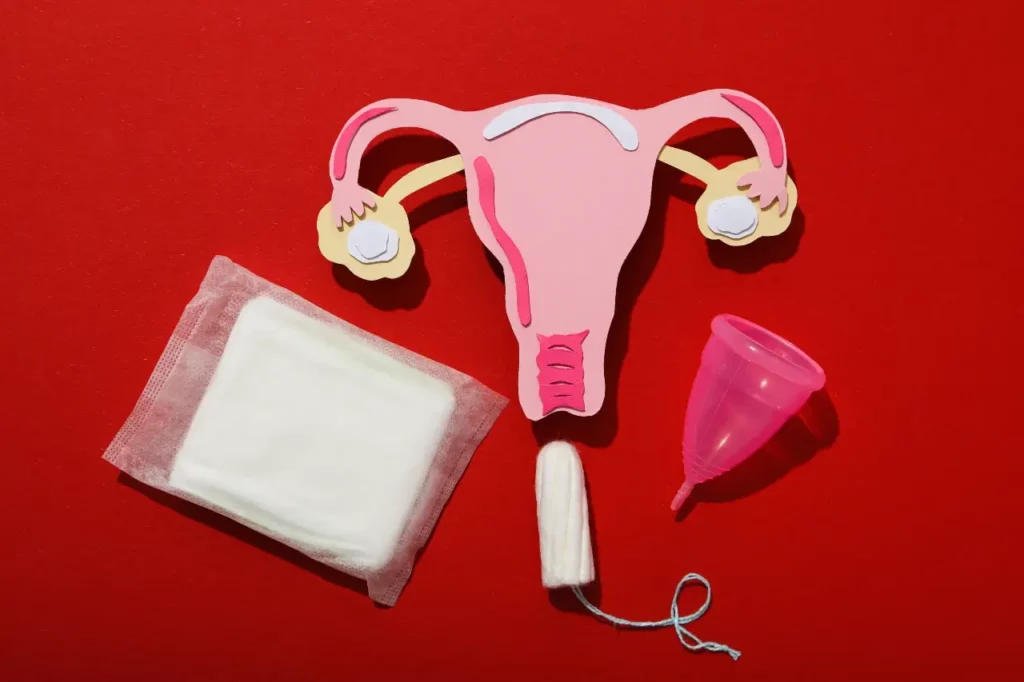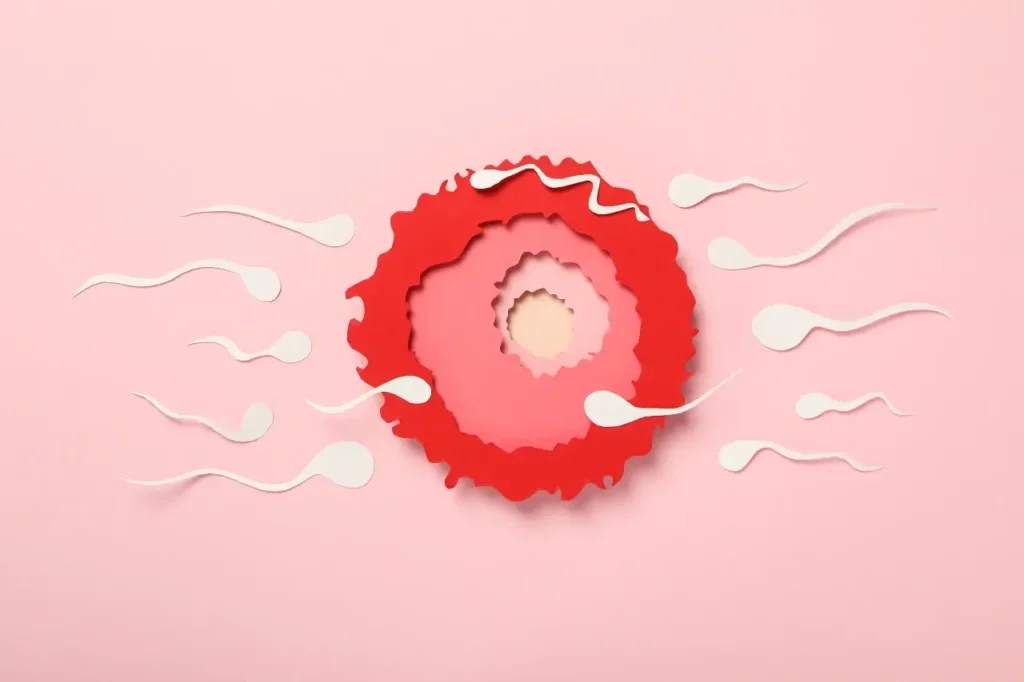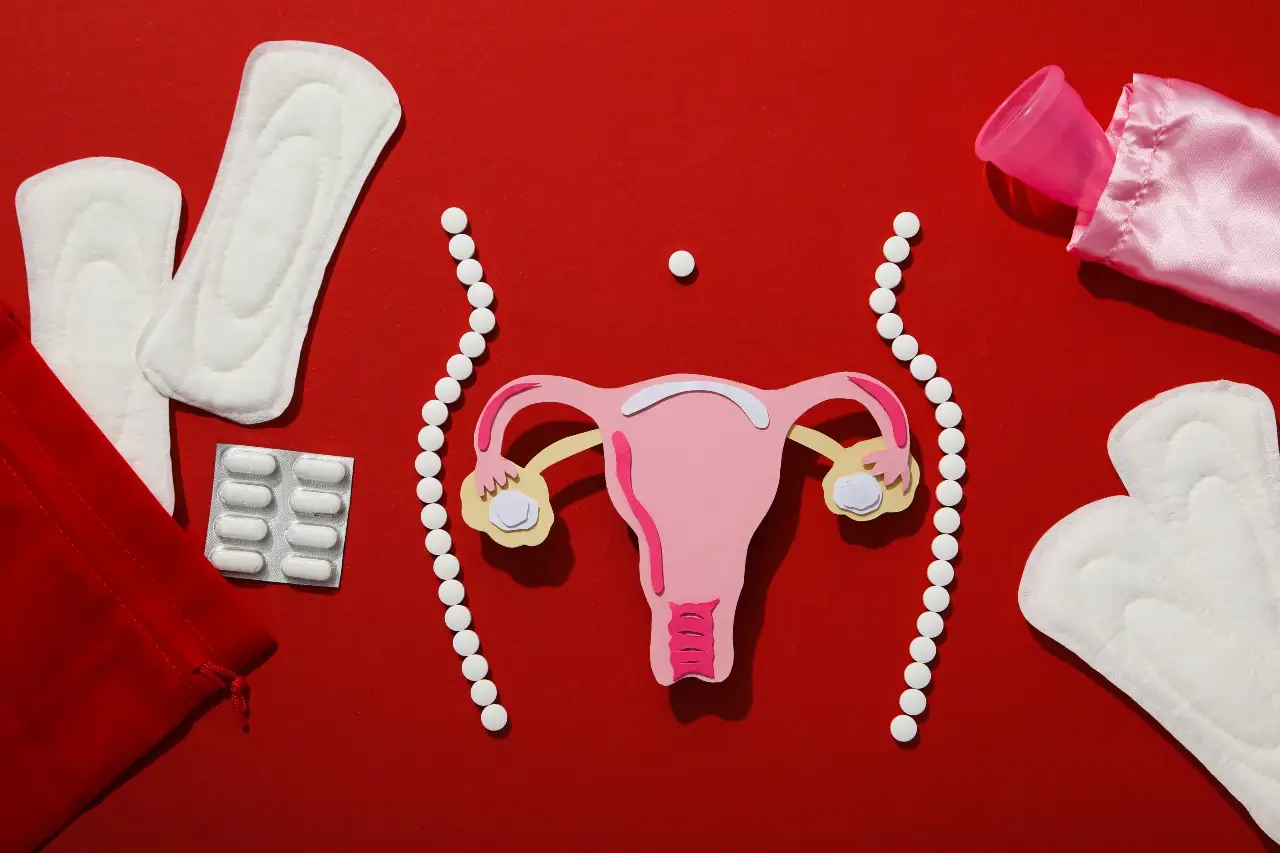We all know that feeling:
“Ah, here we go again.”
“That time of the month.”
“Time to get into my sweats and break out the chocolate.”
Not to mention the number of times you hear, “It must be ‘that’ time of the month,” because you’re a little short-tempered.
These comments give menstruation a bad rep and make you feel embarrassed and gross because you’re on your period.
Many of us go through our monthly cycle without really understanding what’s happening behind the scenes.
It’s not until something’s wrong and we need to know about our cycles that we delve into research.
Understanding your menstrual cycle phases isn’t just about tracking when your next period might be due; it’s about getting insights into your health.
Knowledge isn’t just power—it’s empowering.
By embracing and understanding the changes your body goes through, you can make more informed decisions about your health and lifestyle.
And learn to love your body and menstrual cycle.

What is a Menstrual Cycle and Why Do We Have One?
The first moments of womanhood can be scary and quite surreal.
I remember the day that I got my period, my first thought, was “Oh sh*t, I’m fertile”
But I’m sure this is not a normal reaction for a 13-year old girl.
I’d think most girls would sit there staring at the toilet paper, having an internal freak-out for at least a couple of minutes.
So, what exactly is the menstrual cycle, and why is it such a fundamental part of female biology?
Let’s break it down:
What’s a menstrual cycle?
The menstrual cycle is the series of changes your body goes through monthly in preparation for the possibility of pregnancy.
A normal cycle is 28 days long on average.
Each month, your body prepares an egg that, if fertilised, could develop into a pregnancy.
And if the egg isn’t fertilised?
The lining of your uterus sheds, and voila — you have a period.
Which hormones are involved?
It’s all controlled by hormones.
Oestrogen and progesterone are the main players here.
There’s also luteinizing hormone (LH) and follicle-stimulating hormone (FSH).
These all rise and fall at different phases throughout your cycle, coordinating the timing of the egg release and the preparation of the uterus for potential pregnancy.
How does this impact my emotional well-being?
These hormonal fluctuations can affect more than just your reproductive health.
They can influence your mental health, metabolism, and even how you handle stress.
It’s all interconnected.
Our bodies are amazing… and complicated.

The 4 Menstrual Cycle Phases
Knowing about the menstrual cycle in detail helps you understand many of the symptoms and feelings you experience throughout the month.
Let’s delve into each phase, focusing on what happens and how you can manage and embrace these changes.

Menstrual Phase
Contrary to common belief, your menstrual cycle actually begins on the first day of your period.
I don’t know about you, but I always thought that my period signalled the end of my cycle.
During this phase, if there is no fertilised egg, the thickened lining of the uterus breaks down and is shed through the vagina.
Typically from day 1 to day 5.
What’s happening with my hormones?
Oestrogen and progesterone levels both decline, which signals the body to begin menstruation.
Common symptoms Include:
Cramps, mood swings, and dips in energy—thanks to the lower hormone levels.
Tips for managing discomfort:
Using heat pads for cramps, staying hydrated, and perhaps gentle exercise like yoga or walking, can all help ease your symptoms.
Also, ensure you’re getting enough iron to compensate for the blood loss.
Did you know: Studies show that eating dark chocolate (70% or more cocoa content) can actually help relieve period pain.
So, you don’t have to feel guilty about eating a whole bar to yourself!
Follicular Phase
Starting right after menstruation begins, the follicular phase overlaps with the menstrual phase for a few days until about day 13.
The body starts to prepare to release another egg, also known as ovulation.
What are my hormones doing?
The pituitary gland secretes FSH, which stimulates the ovaries to produce several follicles.
Each follicle will develop into a mature egg.
As these follicles mature, they produce oestrogen, which helps thicken the uterine lining in preparation for a potential pregnancy.
Symptoms include:
A noticeable increase in energy and changes in cervical mucus, which becomes clearer and more stretchy, signalling fertility is at its peak.
Nutrition and activity during this phase include:
This is a great time to engage in more strenuous physical activities, as your energy levels might be higher.
Eating foods rich in protein, vitamins and minerals can support your body’s increased nutritional needs, focusing on vitamins B, E, magnesium, and calcium.

Ovulatory phase
The ovulatory phase is a pivotal moment in the menstrual cycle when an egg is released from one of the ovaries, typically occurring around day 14 in a 28-day cycle.
What are my hormones doing?
This release happens in response to a surge in LH and FSH.
Oestrogen levels also peak just before the egg is released, which helps to trigger this LH surge.
Symptoms can include:
mid-cycle pain, often referred to as mittelschmerz, and an increased libido, which nature cleverly aligns with your most fertile days.
Tracking ovulation:
For those trying to conceive or using natural contraception methods, it’s crucial to be aware of the five days leading up to and including ovulation day.
Sperm can survive inside the vagina for up to five days, so these are your high fertility days.
However, it’s important to note that you can get pregnant at any time in your cycle, even during your period, although the likelihood is much lower.
Signs such as changes in cervical mucus and slight rises in basal body temperature can help predict ovulation.
Luteal phase
Following ovulation, the body enters the luteal phase.
If the egg isn’t fertilised, this phase focuses on preparing the body to either support a pregnancy or start a new menstrual cycle.
What are my hormones doing?
The ruptured follicle transforms into the corpus luteum, which secretes progesterone to maintain the uterine lining.
Oestrogen levels also rise, though not as high as before ovulation.
If no egg is implanted, progesterone levels drop leading to menstruation.
Common symptoms include:
Premenstrual syndrome (PMS), fatigue, and specific food cravings, all due to hormonal shifts—particularly the increase in progesterone.
Recommendations for emotional and physical care include:
Engaging in stress-relieving activities like yoga or meditation.
Also maintaining a balanced diet rich in magnesium and B6 (which may ease some PMS symptoms) and whole foods to combat cravings.
Also ensuring you get enough rest can help.
Managing stress and maintaining a healthy lifestyle during this phase can significantly alleviate symptoms and improve your overall well-being.
Also recognising and validating your feelings during this emotionally turbulent phase can also be really helpful.

How to track your cycle: tools and techniques
Understanding the nuances of your menstrual cycle can greatly benefit from effective tracking methods.
With advances in technology and a variety of tools available, it’s easier than ever to get a clear picture of your cycle phases and how your body changes throughout.
Apps
Many turn to smartphone applications like Clue, Natural Cycles or Flo to keep tabs on their menstrual cycles to try and fall pregnant or as a form of non-hormonal, natural contraception.
These apps have so many benefits, such as the ability to track a variety of symptoms, predict future cycles, and even monitor fertility windows.
They use algorithms to learn from the data you enter, which means the more you use them, the smarter they get, offering you increasingly accurate predictions about your cycle.
Wearable technology
For those interested in a more high-tech approach, wearable technology like smartwatches and smart rings can be quite useful.
These devices track physical changes such as basal body temperature fluctuations and heart rate variations that correlate with different phases of the menstrual cycle.
This data can help you understand when you’re ovulating or when to expect PMS symptoms, providing an easy and effective way to monitor your cycle.
Something that you should note is that basal temperature is different than the temperature that your regular thermometer tells you.
It’s more accurate because it measures to 2 decimal places (for example, 35.75℃ rather than just 35.7℃).
Calendar Method
For those who prefer a more traditional or straightforward method, simple calendar tracking can be very effective, especially for those with regular cycles.
If you have irregular periods, its better to stick with an app and pay close attention to your symptoms through your cycle to make sure youre not caught off guard.
Marking the start and end of your period each month can help you predict future cycles with reasonable accuracy.
Symptom Journaling
Documenting your daily symptoms can offer deep insights into your menstrual health.
By noting changes in cervical mucus, body temperature, mood, and physical symptoms like cramps or breast tenderness, you can begin to notice patterns.
This practice helps in better predictions and enhances your understanding of how your body uniquely responds to each phase of your cycle.
It can also help you realise if something isn’t quite right— extremely painful periods could be a sign of endometriosis of PCOS.

Empowering your menstrual health journey
Understanding the 4 menstrual cycle phases highlights how each phase impacts your reproductive health and overall well-being.
Tools like apps, wearables, calendar tracking, and symptom journaling help you tune into your body’s signals and understand its rhythms better.
This empowerment through knowledge helps you understand your body’s processes, making it easier to manage everyday life in sync with your cycle.
Continue to educate yourself and participate in discussions about menstrual health.
Conversations about menstruation often carry a stigma and can lead to feelings of embarrassment or secrecy.
By talking openly about menstrual health, we can destigmatise this natural biological process and foster a community where everyone feels comfortable sharing and gaining knowledge.
Encourage your friends, siblings, and even colleagues to speak openly about their experiences and share insights.
This openness not only supports personal growth but also builds a supportive network that can transform how society perceives menstrual health.
Remember that understanding your menstrual cycle is a huge step towards embracing and taking charge of your health.
Each piece of knowledge adds to a foundation that not only enhances your daily life but also supports long-term health and wellness.
Terminology
1. Menstrual Phase: This is the first phase of the cycle, (a.k.a a period), beginning with the first day of menstruation, where the body sheds the uterine lining built up from the previous cycle.
2. Follicle-Stimulating Hormone (FSH): A hormone secreted by the pituitary gland that plays a crucial role in the growth of ovarian follicles, which house the eggs prior to maturity and release.
3. Progesterone: A hormone released primarily in the second half of the menstrual cycle by the corpus luteum in the ovary. It helps maintain the uterine lining for a potential pregnancy after ovulation.
4. Oestrogen: A group of hormones that play an essential role in the development and regulation of the female reproductive system and secondary sexual characteristics. During the menstrual cycle, oestrogen levels rise as the egg matures, promoting a thickening of the uterine lining.
5. Ovulation: The release of a mature egg from one of the ovaries, typically occurring in the middle of the menstrual cycle. This is the body’s peak time for fertility each month.
6. Luteinizing Hormone (LH): A hormone produced by the pituitary gland that triggers ovulation and development of the corpus luteum.
7. Corpus Luteum: The remnant of the follicle that has released a mature egg during ovulation. It secretes hormones like progesterone and some oestrogen to support pregnancy during the early stages.
8. Mittelschmerz: A German term meaning “middle pain,” referring to the lower abdominal pain some women experience during ovulation.
9. Basal Body Temperature: The lowest body temperature attained during rest, usually measured immediately after waking up. It is often tracked to help detect ovulation, as a slight rise in temperature occurs after ovulation due to increased progesterone.
10. Premenstrual Syndrome (PMS): A group of symptoms linked to the menstrual cycle, typically occurring just before menstruation. Symptoms can include mood swings, tender breasts, food cravings, fatigue, irritability, and depression.
11. Cervical Mucus: A fluid secreted by the cervix, influenced by hormonal changes, which changes in consistency and quantity throughout the menstrual cycle, becoming more fertile (clear and stretchy) around ovulation.


